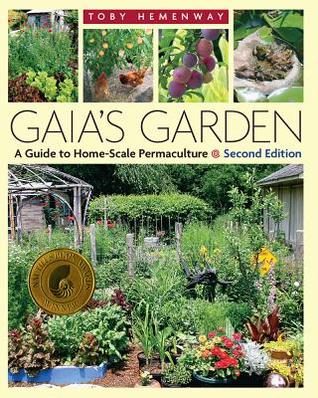Permaculture is a philosophy of working with, rather than against nature; of protracted and thoughtful observation rather than protracted and thoughtless labor; and of looking at plants and animals in all their functions, rather than treating any area as a single product system.For a good visual, here's a great video from Possible.org that shows a food forest, just one technique that fits into the overall concept of permaculture:
One of my goals for the next two months is to read about permaculture, and I got off to a good start with Gaia's Garden: A Guide to Home-Scale Permaculture by Toby Hemenway. This book assumes some basic gardening knowledge, and I got by fine with my very minimal experience.
Hemenway is a great writer, and I was happy to find that the book has loads of examples of practical applications rather than simply being theoretical. He focuses on how and why these techniques work rather than on selling their importance, which was refreshing. It's smart to assume that someone who picks up this book doesn't need a lot of convincing that permaculture is valid.
Here are some of the things I found particularly interesting and/or relevant to my own situation:
- You can do amazing things with a quarter-acre suburban plot. I've been so anti-suburb, and the prevalence of lawns is a huge part of this. Not sure I'd choose to live in one, but it softens my opinion of them a lot to know that I could have a dozen fruit trees and a major abundance of other fruits and vegetables in a yard the size of my parents'.
- Sheet mulch!!! In planning what I want to do with my own yard, I've been thinking about trying out some intensive techniques like double-digging. But I'm convinced that investing my time and energy into tracking down materials for sheet mulching rather than digging and digging is ultimately a much better option.
- Keyhole beds are a smart way to save space in small yards - or even around the house in big yards. Plus, they add more visual interest through contour, compared to a bunch of rectangular raised beds (although I do love the orderliness of those).
- Dandelions are actually excellent plants. Their long tap roots pulls nutrients from deep in the ground and concentrates them in their leaves. Nutritious to eat, plus excellent for compost. They help turn crappy soil into great soil. Same goes for burdock, which Aaron furiously and angrily eradicated from our backyard last year - and we took all the greens to the city compost in fear that composting them at home would somehow lead to a massive invasion of them all over the yard. Lesson learned.
- Re-using graywater in the garden saves a lot of energy. It's not hard at all to wash dishes in a tub and dump the water into the garden beds. Could even route the washing machine to drain into a barrel outside and use that to drip-irrigate a dry spot.
- Nitrogen fixers are very important. I already love peas and beans (so, so much), but I'm convinced to plant them among all my other plants instead of keeping them to their own beds. Hemenway argues that even while the nitrogen-fixers are alive, they're sharing the nitrogen they took from the air with the surrounding soil and plants as their roots grow and die in response to levels of water. This is also another excellent reason to finally plant my favorite perennial: lupines.
- Guilds are amazing. By planting in proximity a variety of things that serve a variety of purposes and interact with each other to mutual benefit, you can greatly increase yields - compared to relegating each type of plant to its own bed. The classic and ideal example of a guild is the three sisters: corn, beans, squash. The corn grows tall and supports the beans that crawl upwards, the beans take nitrogen out of the air and share it with the corn and squash, and the squash acts as a living mulch to shade the soil and help retain moisture. The book gave me a lot of good ideas for how to plant my sour cherry tree(s) with a bunch of other plants that will help each other out, and I generally plan to interplant as much as possible.
- Taking the time to observe what's going on before leaping to conclusions about how to fix or maximize anything is really important. Also, action might be more important than planning. For me, anyway. It'd be one thing if I were attempting to transform the entire yard in one season. But I don't have the resources to do that. Instead, I'll build slowly and watch how things work as I go.
- Chickens can be a valuable addition to a yard for reasons well beyond their eggs. You can make a moveable enclosure for them so they can help prep beds - by eating weeds, scratching and tilling, and pooping. Plus they're an efficient composting system. Saint Paul stupidly prohibits composting soiled chicken litter, but in this I'd be more inclined to follow ethics than law.
- Urban gardens can be really successful, especially if you think beyond your own yard and share widely with neighbors. This could be challenging on my block, where we can't even get together to hire a plow for our alley, but I think pushing myself to be more social with my neighbors will have a lot of benefits. Starting by offering something - tomatoes, lettuce, zucchini, beans, whatever - will feel more natural than just trying to strike up a conversation (painfully awkward for me).
There's so much more useful information in the book, but I just wanted to highlight these to give some order to the mass of thoughts whirling around in my head. I'll share more of what I learn as I read more, spend some real time observing, and put plans into action.
